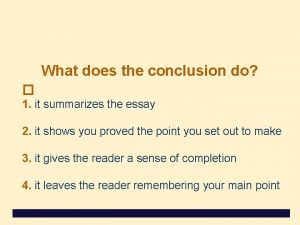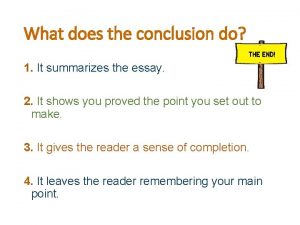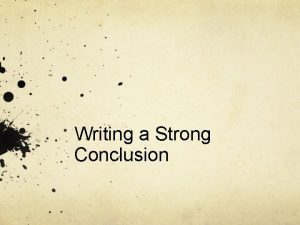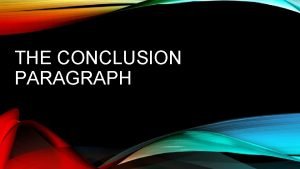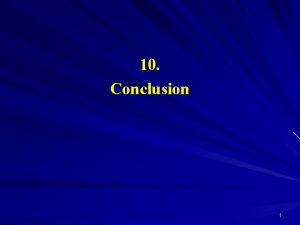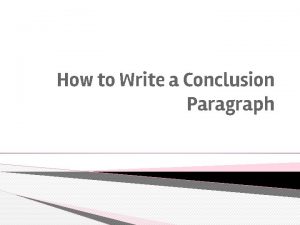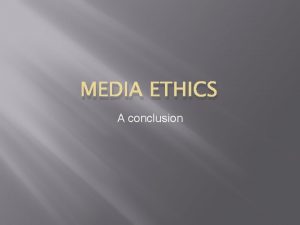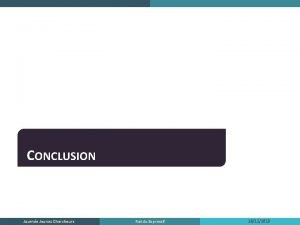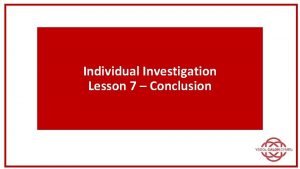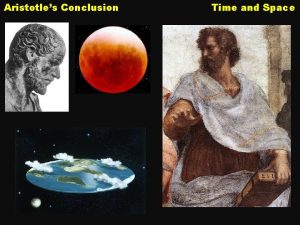What does the conclusion do 1 It summarizes













- Slides: 13


What does the conclusion do? � 1. It summarizes the essay 2. It shows you proved the point you set out to make 3. It gives the reader a sense of completion 4. It leaves the reader remembering your main point

Wait, that sounds kind of like the introduction! So, what is the difference between the introductory paragraph & the concluding paragraph? The difference is in the approach to the topic.

Think of these two paragraphs as funnels, one leading toward the body of your essay, while the other leads the reader away from the body. The introduction begins with a general approach to the topic and then moves toward the more specific aspect(s) of it • • The conclusion begins with the more specific aspect(s) and moves toward the general topic of your essay

What main point did you want to make in your essay? • Did you make that point? • Summarize it in your conclusion. • Often you can use the introductory paragraph as a guide. This will help you come full circle and give your reader a sense of completion.

Perhaps you began your essay by saying: Man controls how he interacts with the environment and sometimes he makes a mistake. Then you might make this the first sentence of your conclusion: Mankind’s effect on the environment can have devastating results.

Other Ways to Summarize the Essay's Main Points: • Refer briefly to the topic of each paragraph you wrote. • Leave readers with something to think about. • Suggest something readers can do about what they have just read.

How to Structure the Final Paragraph 1. Topic sentence: repeat the ideas in your thesis statement, but with deeper understanding 2. Supporting sentences: summarize the main points in the body of your essay 3. Closing sentence: connect back to the introduction to "clinch" the ideas in the essay, showing their importance

What if a new idea tries to sneak into that final paragraph? If it's really important, give it a paragraph of its own in the body of the essay. The concluding paragraph is not the place to introduce new information or make more points about the topic.

The "So What? " Tip for Writing an Effective Conclusion After writing your topic sentence, ask yourself: "So what? Why is that important? " Your next sentence should explain why. Then ask yourself again: "So what? Why is that important? " And so on.

Example of the "So What? " Method of Starting the Concluding Paragraph: "Education is very important in society. " "So what? Why is it important? " "It gives all citizens an equal start. " "So what? Why is that important? " Can you write an answer?

Strategies for Ending the Concluding Paragraph: 1. Perhaps add a quotation or surprising insight from the materials you researched. 2. Suggest some action to take or a solution to an issue. 3. Point out broader consequences of the points you have made.

What NOT to Include in the Concluding Paragraph: 1. Overused phrases: "in conclusion, " "in summary, " "in closing" 2. A new idea or subtopic 3. Supporting evidence or details (these should be in the body of the essay)
 Hình ảnh bộ gõ cơ thể búng tay
Hình ảnh bộ gõ cơ thể búng tay Ng-html
Ng-html Bổ thể
Bổ thể Tỉ lệ cơ thể trẻ em
Tỉ lệ cơ thể trẻ em Voi kéo gỗ như thế nào
Voi kéo gỗ như thế nào Tư thế worms-breton
Tư thế worms-breton Hát lên người ơi alleluia
Hát lên người ơi alleluia Các môn thể thao bắt đầu bằng tiếng nhảy
Các môn thể thao bắt đầu bằng tiếng nhảy Thế nào là hệ số cao nhất
Thế nào là hệ số cao nhất Các châu lục và đại dương trên thế giới
Các châu lục và đại dương trên thế giới Công thức tính độ biến thiên đông lượng
Công thức tính độ biến thiên đông lượng Trời xanh đây là của chúng ta thể thơ
Trời xanh đây là của chúng ta thể thơ Mật thư anh em như thể tay chân
Mật thư anh em như thể tay chân 101012 bằng
101012 bằng














